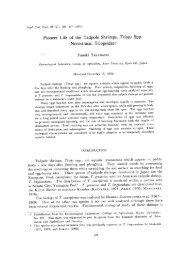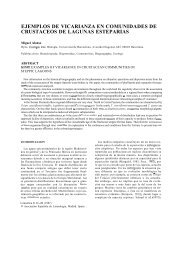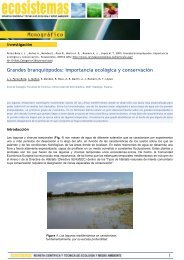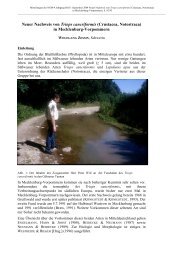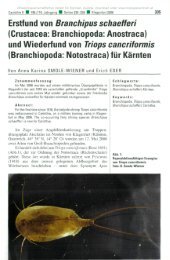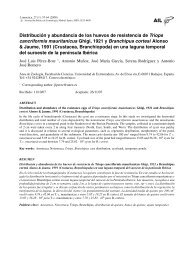Reproductive isolation and genetic differentiation in North American ...
Reproductive isolation and genetic differentiation in North American ...
Reproductive isolation and genetic differentiation in North American ...
Create successful ePaper yourself
Turn your PDF publications into a flip-book with our unique Google optimized e-Paper software.
132<br />
In T. longicaudatus, <strong>in</strong> contrast, there is a clearer<br />
demarcation between populations differ<strong>in</strong>g <strong>in</strong> sex<br />
ratio, <strong>and</strong> reproductive differences are associated with<br />
the pattern<strong>in</strong>g of <strong>genetic</strong> relatedness. Unisexual populations,<br />
<strong>in</strong> particular, appear as a ‘monophyletic’ clade<br />
<strong>in</strong> both distance phenograms <strong>and</strong> maximum likelihood<br />
dendrograms (their common node is marked by<br />
a square <strong>in</strong> Figure 2), <strong>and</strong> the one <strong>and</strong>rodioecious population<br />
(Ch<strong>in</strong>le Wash) is the sister group to all of the<br />
gonochoric populations of T. longicaudatus <strong>in</strong> the distance<br />
phenogram (Figure 2A). Of the 48 alleles identified<br />
<strong>in</strong> T. longicaudatus, two were found only <strong>in</strong> asexual<br />
populations, one was unique to the <strong>and</strong>rodioecious<br />
population, 17 were found only <strong>in</strong> sexual populations,<br />
<strong>and</strong> the rema<strong>in</strong><strong>in</strong>g 28 were shared between at least two<br />
different k<strong>in</strong>ds of populations.<br />
Conventional statistics of <strong>genetic</strong> variability were<br />
calculated from the gene frequency data for those populations<br />
<strong>in</strong> which at least five <strong>in</strong>dividuals were scored<br />
for the 21 loci. The number of alleles per locus <strong>and</strong> the<br />
number of loci polymorphic (at the criterion that the<br />
most common allele was <strong>in</strong> a frequency less than 0.99)<br />
were obta<strong>in</strong>ed by direct count; the effective number<br />
of alleles at each locus, n e , was calculated from the<br />
frequencies of each allele, p i ,asn e =(p i 2 ) 1 ,<strong>and</strong><br />
expected heterozygosity at each locus was calculated<br />
from the b<strong>in</strong>omial expansion of the <strong>in</strong>dividual allele<br />
frequencies. These statistics were then averaged over<br />
loci <strong>and</strong> over populations for each of the reproductive<br />
types (Table 2).<br />
In T. longicaudatus, there is a strong correlation<br />
between reproductive mode <strong>and</strong> <strong>genetic</strong> diversity.<br />
Obligately sexual (gonochoric) populations are<br />
quite variable, by any measure, <strong>and</strong> the variability is<br />
comparable to that found <strong>in</strong> other species of <strong>in</strong>vertebrate<br />
animals (e.g., Powell, 1975; Nevo, 1978; Nei,<br />
1987). Unisexual populations, <strong>in</strong> contrast, are completely<br />
lack<strong>in</strong>g <strong>in</strong> detectable variation. Although these<br />
populations sometimes differ from each other at some<br />
loci (Appendix 3), there is no <strong>in</strong>tra-populational variation.<br />
The one <strong>and</strong>rodioecious population from Ch<strong>in</strong>le<br />
Wash is <strong>in</strong>termediate <strong>in</strong> all measures of <strong>genetic</strong> diversity.<br />
Genetic variance is lower, on average, <strong>in</strong> T. newberryi<br />
that <strong>in</strong> T. longicaudatus. Androdioecious populations<br />
have somewhat more variance than unisexual<br />
ones, but unisexual populations are not completely<br />
homogeneous, as they are <strong>in</strong> T. longicaudatus (Table 2).<br />
Comparisons between the two species, of populations<br />
with the same reproductive mode, suggest that a primary<br />
determ<strong>in</strong>ant of <strong>genetic</strong> variation is reproductive<br />
mode.<br />
Geographic patterns of <strong>genetic</strong> <strong>differentiation</strong><br />
Although distance phenograms, such as the one illustrated<br />
<strong>in</strong> Figure 2, describe the <strong>genetic</strong> relatedness of<br />
populations, <strong>and</strong> are based on the same data that provide<br />
<strong>in</strong>formation on <strong>genetic</strong> exchange between populations,<br />
they do not <strong>in</strong>clude any explicit <strong>in</strong>formation on<br />
the geographic proximity of populations. To exam<strong>in</strong>e<br />
the spatial scale of population <strong>differentiation</strong> we used<br />
methods recently developed by Slatk<strong>in</strong> (1991, 1993).<br />
His method <strong>in</strong>vestigates the relationship between geographic<br />
distance <strong>and</strong> <strong>genetic</strong> difference by relat<strong>in</strong>g<br />
<strong>isolation</strong> by distance to average coalescent times of<br />
genes. Under this model, pairwise estimates of migration<br />
between populations are <strong>in</strong>versely correlated with<br />
the number of steps between them (Slatk<strong>in</strong>, 1993). ^M ,<br />
the value of Nm (the product of population size <strong>and</strong><br />
per capita migration rate) that would be estimated for<br />
a pair of populations from their pairwise <strong>genetic</strong> correlation<br />
() <strong>in</strong> a one-dimensional stepp<strong>in</strong>g-stone model,<br />
is approximately equal to Nm/i, whereiis the number<br />
of steps separat<strong>in</strong>g the two populations. In a onedimensional<br />
array of populations, the expected slope<br />
of the regression of log 10 ( ^M )versuslog 10 (distance)<br />
is 1.0 <strong>and</strong> <strong>in</strong> a two-dimensional array, the expected<br />
slope is 0.5. Simulations <strong>in</strong>dicate that values of<br />
^M based on fewer than ten highly variable, polymorphic<br />
loci can show a pattern consistent with <strong>isolation</strong><br />
by distance despite considerable variation (Hellberg,<br />
1994).<br />
Pairwise values of ^M were obta<strong>in</strong>ed from estimates<br />
of between pairs of populations us<strong>in</strong>g the computer<br />
program of Slatk<strong>in</strong> (1993). The log 10 of the estimated<br />
^M values were plotted aga<strong>in</strong>st the log 10 of the geographic<br />
distances for pairs of populations with<strong>in</strong> T.<br />
newberryi <strong>and</strong> with<strong>in</strong> sexual populations of T. longicaudatus.<br />
The analysis for T. newberryi was based on<br />
9 populations <strong>and</strong> 7 loci <strong>and</strong> the analysis for T. longicaudatus<br />
on 5 populations <strong>and</strong> 14 loci. Populations<br />
with fewer than 5 <strong>in</strong>dividuals sampled were excluded<br />
because variability <strong>in</strong> sample sizes can lead to negative<br />
^M values. S<strong>in</strong>ce the number of steps separat<strong>in</strong>g actual<br />
populations is measured with error, both ord<strong>in</strong>aryleast-squares<br />
(OLS) <strong>and</strong> reduced-major-axis (RMA)<br />
regression were used to characterize the relationship<br />
of gene flow <strong>and</strong> distance (Hellberg, 1994).<br />
Sexual populations of T. longicaudatus exhibit a<br />
strong relationship between <strong>genetic</strong> distance <strong>and</strong> geo-



